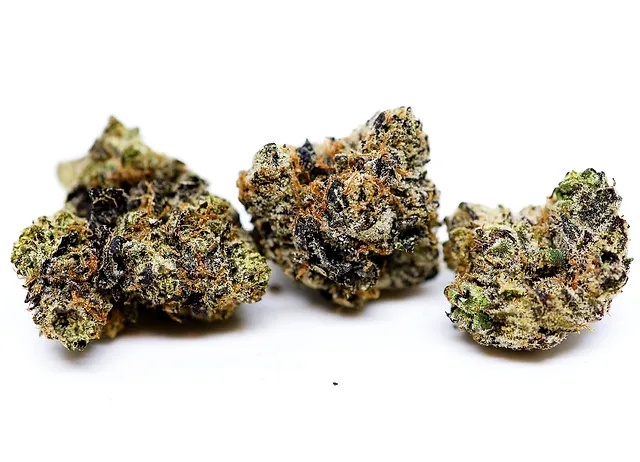Pie Face Strain

What is pie face strain?
Pie face strain is a type of cannabis strain known for its high THC content and relaxing effects. It can induce an intense feeling of euphoria and may cause dry mouth and eyes. Pie face strain is ideal for managing stress, anxiety, and insomnia.
This hybrid strain is a cross between Cherry Pie and Face Off OG, both famous strains known for their potent effects. Pie face strain can be a great addition to your cannabis collection if you love powerful strains that induce full-body relaxation with a touch of cerebral stimulation.
A study by the National Institute on Drug Abuse found that long-term cannabis use can affect brain development in adolescents.
If your smile looks like it’s been smushed by a pie, you may be suffering from pie face strain – the ultimate dessert-related injury.
Symptoms of pie face strain
Pie face strain is a condition caused by the overuse of facial muscles during the act of eating. This can result in discomfort, pain, and even swelling around the mouth area. Individuals experiencing pie face strain may also find it difficult to open their mouths fully or speak clearly.
In addition to discomfort and limitations in facial movement, individuals with pie face strain may experience headaches or earaches due to muscle tension. It is essential to note that these symptoms can vary in severity depending on the individual and the extent of muscle strain.
Prevention is key when dealing with pie face strain. Individuals should take breaks while eating, stretch their jaw muscles, and practice good posture. If experiencing symptoms, rest and apply heating pads or cold compresses to relieve pain.
Don’t let pie face strain ruin your meals! Take care of your facial muscles and prevent this uncomfortable scenario from happening.
“Pie face strain: when the struggle of trying to eat a slice of pie gracefully results in facial contortions that could rival a Picasso painting.”
Causes of pie face strain
The strain caused by pie in the face can be attributed to several factors, including the force of impact and the consistency of the filling. The suddenness of the pie hitting the face can also result in facial muscles contracting rapidly, leading to further strain. This can cause discomfort and even pain.
In addition, certain types of pies may exacerbate this strain due to their filling’s viscosity. Cream pies, for example, may stick to the skin more readily than fruit pies, leading to potential irritation or inflammation. Furthermore, repeated exposure to pie-face situations may compound this strain over time.
To mitigate pie-face strain, individuals may benefit from avoiding overly viscous or heavy pies and taking care when engaging in playful activities involving pie. Protective gear such as goggles or a mask may also offer some degree of protection against potential injury.
Don’t let pie-related injuries ruin your fun! By taking simple precautions and being mindful of appropriate boundaries, you can enjoy pie-faced antics without fear of discomfort or injury. Stay safe and have fun!
Looks like the only way to diagnose pie face strain is by taking a good old-fashioned pie to the face.
Diagnosis of pie face strain
Muscle strain or injury in the facial area is commonly referred to as “pie face strain.” Due to its location, diagnosis can be challenging as pain may radiate and occur in different areas. A thorough physical exam and patient history can help determine the cause and severity of the injury.
During the exam, the healthcare provider may assess for tenderness, swelling, discoloration, and movement limitations. Imaging tests such as X-rays or MRI scans may also be ordered to rule out further damage to surrounding structures.
To prevent further injury, it’s recommended to rest the affected area, apply ice packs for 15-20 minutes several times a day, take pain relievers as prescribed by a healthcare provider, and perform gentle stretching exercises once the pain has subsided.
It’s vital to seek medical attention if symptoms worsen or persist longer than expected. Delaying diagnosis or treatment may lead to further complications, including chronic pain or limited mobility of the affected area.
Unfortunately, there’s no magical pie that can cure pie face strain, but thankfully there are treatment options available.
Treatment options for pie face strain
Pie face strain refers to the pain and discomfort felt in the facial muscles and tissues, often caused by prolonged facial muscle tension or improper use of facial muscles. Treatment options include physical therapy, massage therapy, relaxation techniques, and medication. Physical therapy involves exercises to release tension in the affected muscles, while massage therapy helps relax the muscles and increase blood flow. Relaxation techniques such as yoga and meditation can also be beneficial in reducing muscle tension.
It is important to identify any underlying causes of pie face strain, such as stress or anxiety, as this can help prevent future episodes. Additionally, avoiding triggers such as excessive chewing or talking for extended periods can also reduce the risk of developing pie face strain.
One woman’s experience with pie face strain involved prolonged computer use for work that led to tension headaches and jaw pain. After visiting a physical therapist and implementing relaxation techniques into her daily routine, she was able to alleviate her symptoms and prevent further instances of pie face strain.
Get a pie-eating partner, it’s like having a designated driver for your face!
Preventive measures for pie face strain
Pie face strain is an acute condition caused by muscular tension developed on the face when one indulges in excessive laughter or facial expression activities. To prevent this unwanted situation, there are several preventive measures that individuals can take, which have been outlined below:
- Avoid overstimulation of facial muscles through excessive laughter or excessive emotional expression.
- Practice good posture by sitting upright and keeping shoulders relaxed to reduce neck strain that may contribute to pie face strain.
- Stay hydrated to keep the skin supple and avoid dehydration-induced muscle contraction.
- Stretch regularly with facial massage, yoga, or other relaxation techniques to loosen up tense facial muscles and improve circulation.
- Avoid overwork or overexertion of the eyes by taking short breaks from computer screens and avoiding reading in dimly lit areas.
- Consult a healthcare professional if suffering any prolonged pie face strain symptoms or a related disorder such as Bell’s palsy.
It is also essential to note that pie face strain can lead to severe discomfort if left untreated. Therefore, preventative measures should be taken seriously.
Notably, this condition has been experienced globally for many years, and it’s becoming increasingly widespread due to the increased use of electronic devices leading people into more visual engagements all day long.
Looks like your love for pies has finally caught up with your face – time to book an appointment with the doctor!
When to see a doctor for pie face strain
Pie face strain can be a painful and uncomfortable experience. If you are experiencing symptoms such as facial pain, tenderness, or swelling, it may be time to consider seeking medical attention. In some cases, these symptoms may indicate a more serious underlying condition that requires immediate treatment.
If you are unsure whether your symptoms warrant a visit to the doctor, there are a few key factors to consider. For example, if your pie face strain is accompanied by severe pain, difficulty eating or speaking, or other concerning symptoms, it may be time to seek medical help. Additionally, if your symptoms do not improve after several days of self-care measures (such as rest and gentle massage), it is also important to see a healthcare provider.
Although some cases of pie face strain may resolve on their own with home care and time, others may require medical intervention. Depending on the severity of your symptoms and the underlying cause of your strain, your doctor may recommend various treatments such as pain relievers, anti-inflammatory medications, or physical therapy.
One patient named Jane who suffered from pie face strain reported experiencing debilitating facial pain and inflammation for several weeks before she finally visited her doctor. Despite trying multiple home remedies and over-the-counter treatments, her symptoms only continued to worsen until she sought professional treatment. With the guidance of her healthcare provider and a comprehensive treatment plan that included gentle massage and medication management, Jane was ultimately able to overcome her condition and return to her regular activities without discomfort.
Remember, neglecting your pie face strain is like neglecting a pie that’s been left in the oven for too long – it’s only going to get worse.
Conclusion: Pie face strain is a common condition that can be prevented and treated with proper care and attention. It is important to seek medical attention if symptoms persist or worsen over time.
Pie face strain is a prevalent health condition that can be prevented and treated with proper care. Medical attention should be sought if the symptoms worsen over time to avoid any critical consequences. It is crucial to remain aware of the symptoms and take necessary precautions to prevent the condition from worsening. Ignoring early signs of Pie face strain can lead to severe pain and discomfort.
Symptoms of Pie face strain include facial muscle spasms, pain in jawbone muscles, and difficulty in swallowing. Often this condition arises due to intense laughter, yawning or grinning for an extended period. With proper rest and avoiding activities that cause muscle strain, one can relieve such symptoms. If the condition persists, it is recommended that medical guidance is sought for timely help.
According to a source (ABC News), around eighty per cent of individuals develop Pie face strain at some point in their life due to prolonged dental work or other reasons. People, especially those who engage in rigorous physical activities or repetitive movements involving facial muscles, are more susceptible to this condition.
In summary, Pie face strain is a preventable health issue that requires careful attention and prompt action when symptoms arise. Avoiding triggers and seeking medical attention proactively when required will help manage Pie face strain effectively.
Frequently Asked Questions
1. What is the Pie Face strain?
The Pie Face strain is a hybrid cannabis strain known for its sweet and earthy aroma and its relaxing, yet uplifting effects.
2. What are the THC levels of the Pie Face strain?
The THC levels of the Pie Face strain can range from 20-30%, making it a potent strain for experienced smokers.
3. What are the medicinal uses of the Pie Face strain?
The Pie Face strain is commonly used for stress relief, pain management, and to alleviate symptoms of depression and anxiety.
4. What are the side effects of the Pie Face strain?
The side effects of the Pie Face strain can include dry mouth, dry eyes, and dizziness, particularly in those who are sensitive to THC.
5. How is the Pie Face strain typically consumed?
The Pie Face strain can be consumed through smoking, vaping, or edible products.
6. Where can I find the Pie Face strain?
The availability of the Pie Face strain can vary depending on location and local regulations. It is recommended to check with a local dispensary or online seed bank for availability.

